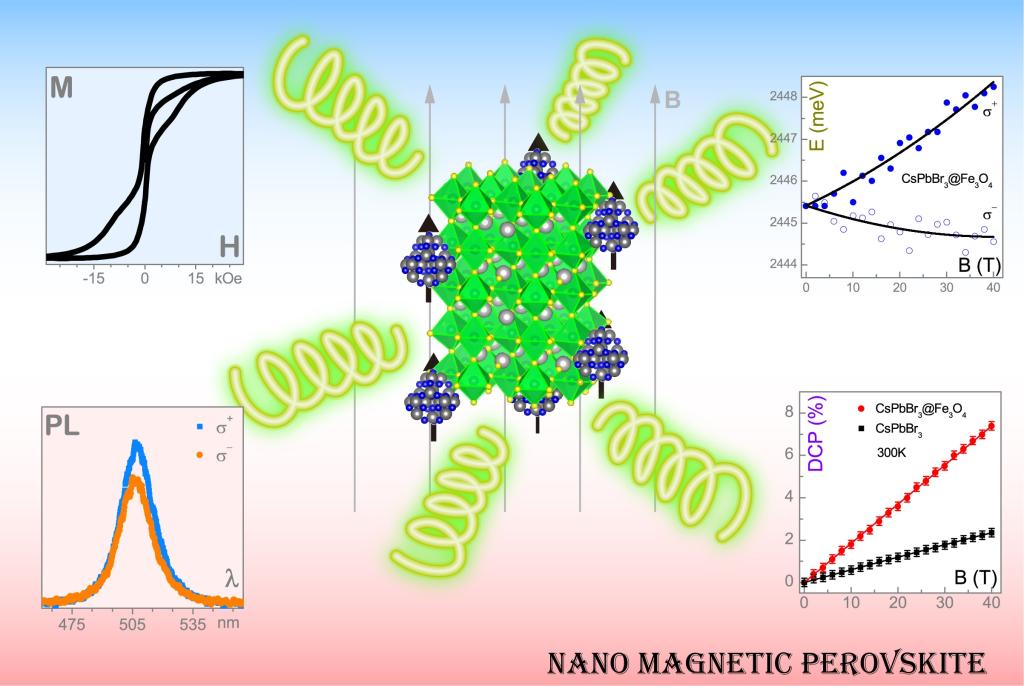
Fig.1: Illustration of magneto-photoluminescence (PL) from the CsPbBr3-Fe3O4 nano-composites. Insets show the magnetization, circularly polarized PL spectra, Zeeman energy splitting, and degree of circular polarization (DCP) of the PL at room temperature.
Background
The generation and manipulation of spin-polarized electrons are the basis of spintronic applications. Spin injection from a ferromagnetic surface or heterojunction to a semiconductor adjacent layer is often used to create spin-polarized carriers. The all-inorganic halide perovskite CsPbrBr3 exhibits wide applications in light- emitting diodes and photodetectors because of their high quantum yield and stability. Doping with transition metal ions produces magnetic properties and can be used for spintronic devices. Exchange interactions between the host and magnetic ions can modulate the electronic, magnetic, and optical properties of dilute magnetic semiconductor materials. Thus, these materials have attracted great attention both in terms of a deeper understanding of the physical mechanisms and practical applications, despite these doped halide perovskites undergo phase separation, leading to an inhomogeneous distribution of dopant ions. However, conventional ion-doped semiconductors suffer from weak magnetic properties and doping inhomogeneity, which are not conducive to the formation of room-temperature spintronic devices and the analysis of the magnetic origin of dilute magnetic semiconductors.
What we discover?
In this study, we synthesize all-inorganic perovskite CsPbBr3 surrounded by Fe3O4 magnetic nano-particles. It is found that this nanocomposite shows both magnetization and magnetic field-induced circularly polarized photoluminescence at room temperature. Specifically, with the attachment of Fe3O4 nano-particles closely on the surface of CsPbBr3 nanocrystals, both the degree of circular polarization and g-factor enhanced by 3.5 times compared with that of pure CsPbBr3. The phenomenon should be due to the formation of exciton magnetic polaron through the coupling of the magnetic aligned nanoparticles with the excitonic state of the host semiconductor in the external magnetic field.
Why is this important?
It is found that the attachment of magnetite nanoparticles greatly enhances the circular polarization of PL of CsPbBr3 at room temperature. The external magnetic field can polarize the uncorrelated and disordered surface spins in the magnetite nanoparticles, and the intraparticle magnetic disorder energy increases sharply toward the defect-rich surface. From this study, it is proved that magnetite nanoparticles can effectively regulate the spin polarization of excitons in halide perovskites, which provide an important material support for spin-photonic applications.
Who did the research?
Yongfu Ma1,2, Ruiqin Huang2, Hongmei Gong3, Enze Kang2, Jingge Chen4, Quanliang Cao2, Yibo Han2*
(1) Department of Optoelectronic Information of Science and Engineering, School of Science, Jiangsu University of Science and Technology, Zhenjiang 212100, P. R. China.
(2) Wuhan National High Magnetic Field Center and School of Physics, Huazhong University of Science and Technology, Wuhan 430074, P. R. China.
(3) School of Optical and Electronic Information, Suzhou City University, Suzhou 215104, P. R. China.
(4) School of Engineering, Institute for Biology, Engineering, and Medicine, Brown University, RI 02912, USA.
Appl. Phys. Lett. 124, 082404 (2024)
https://doi.org/10.1063/5.0190303
Funding
This work was financially supported by the National Natural Science Foundation of China (Grant No. 11974126) and the Key Technologies Research and Development Program of China (Grant No. 2022YFA1602702).
